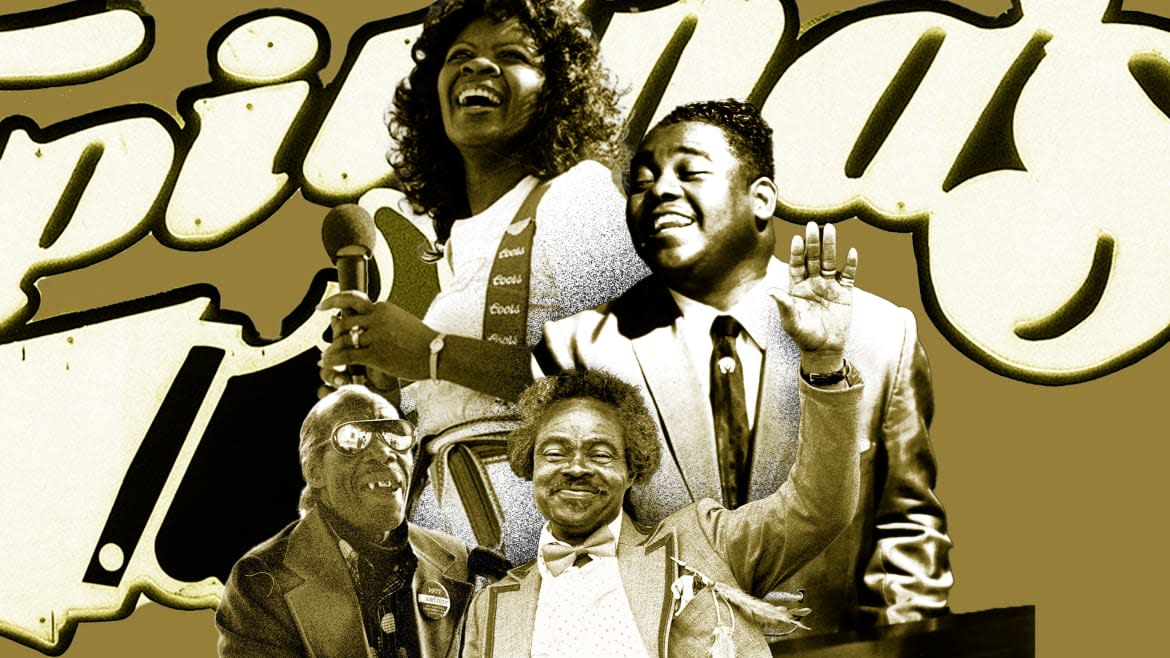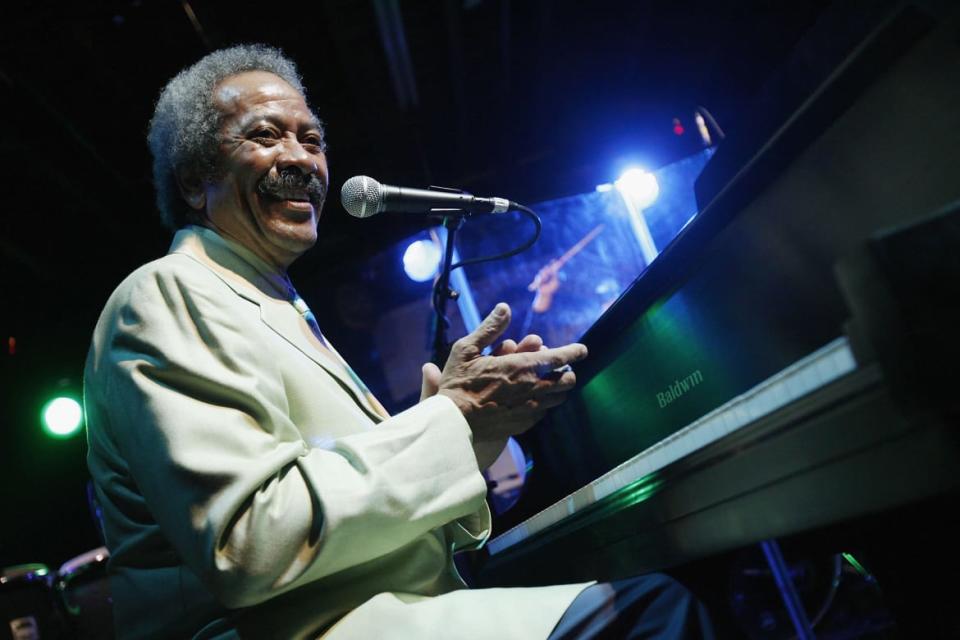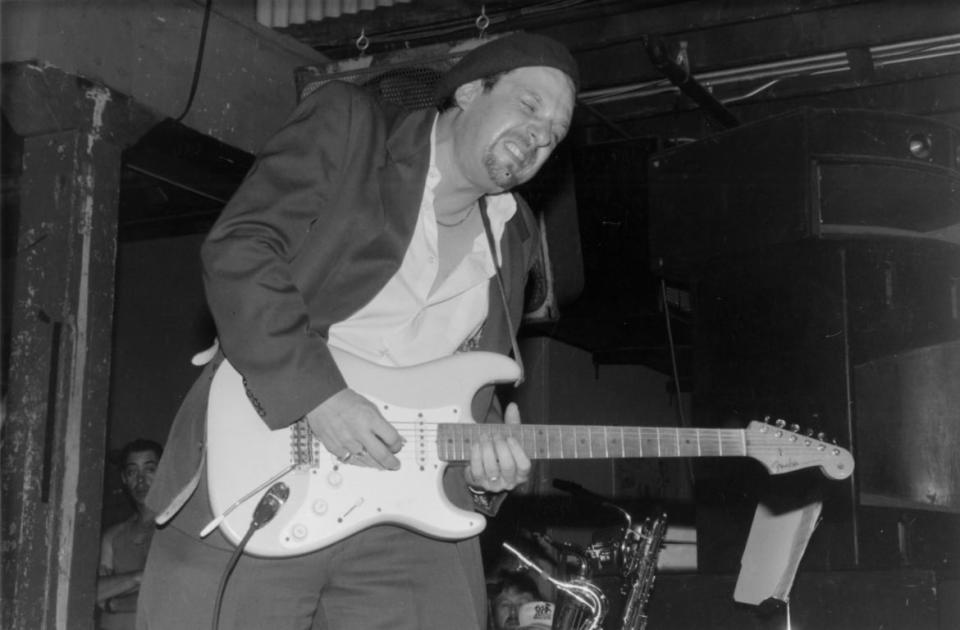New Orleans Legend Tipitina’s Is Back—and With a Club for Vintage Records

Of the storied outposts in American culture, Tipitina’s music club in New Orleans is a heartbeat of the town dubbed “Queen of the Apocalypse” by the late blogger Deb “Big Red” Cotton. Through hurricanes, floods, the BP oil spill, ex-Mayor Ray Nagin’s packing off to a federal penitentiary—his legacy a post-Katrina broken mud town (repaired by Mitch Landrieu)—unto the long pandemic without parades or music venues, the club at the corner of Napoleon Avenue and Tchoupitoulas Street embodies the line of “Indian Red,” a Mardi Gras classic: “We won’t bow down.”
Tipitina’s has reopened after the COVID-19 shutdown with a schedule of major acts as the city lumbers toward the twice-canceled Jazz and Heritage Festival that runs this weekend through the first weekend in May. During the shutdown, as musicians played porch concerts mindful of social distancing, Tipitina’s kept the sounds moving with a limited-edition subscription mail-order club for vinyl recordings of local legends.
The current release is a reissue of Save the Bones by the late guitarist and composer Danny Barker. Previously, the club released Dirty Dozen Brass Band Live with Dizzy Gillespie in New Orleans—recorded in 1985, unreleased till now—and among others, Professor Longhair: Fess at Home, by the rhythm-and-blues piano professor (Henry Roeland Byrd) and his drummer, Alfred “Uganda” Roberts. The tracks were recorded at Byrd’s home in 1973 by Quint Davis, his manager who went on to become executive director of the jazz festival. The mail-order club costs $200 per year for an LP vinyl every other month.
Tipitina’s opened in 1977 when 14 uber-loyal fans of Professor Longhair bought the two-story clapboard structure, built in 1912 and which in earlier phases operated as a gymnasium, gambling house, bordello, and a previous music club—your garden variety New Orleans structural history. Michael P. Smith, the notable photographer and chronicler of parades and churches, was among the founders; they named it for Fess’ signature scat-song, an ode to the mysteriously named Tipitina, “three times seven, girl—knows what you wanna do.”

The exterior of Tipitina’s.
The founders established Tip’s as home base for Fess whose melding of rumba and boogie rhythms on songs like “Big Chief” simulated Carnival parade sounds that exerted enormous influence on the post-war R&B sound and brass band marches. The old man’s performances at the club in the years before his death in 1980 drew packed houses and ecstatic dancing; the backdrop of today's stage is a larger-than-life silhouette of Fess, like a totemic spirit governing music past, music to come.
Longhair and Fats Domino divided the New Orleans piano style between them. Domino’s rocking boogie rhythms with the honey sweet baritone vocals generated a string of major hits, like “Ain’t That a Shame” and “I’m Gonna Be a Wheel Some Day” and made Domino wealthy, a lordly presence at his big house in the Lower Ninth Ward. Fess followed the hard luck road of the bluesman, forging a style on the margins of the culture for most of his life. His early songs, like the madcap “Bald Head,” about a woman losing her wig while making out with the guy-pal at “Lee Circus’s Park” (Lee Circle), kept a groove he kept mining, fashioning a repertoire that by the late 1970s had drawn late-life celebrity, putting him on concert tours.
Longhair’s Afro-Caribbean piano style with strong percussive licks generated a keyboard tradition whose descendants include the dearly departed Allen Toussaint, Dr. John, Art Neville, James Booker, Huey “Piano” Smith, Eddie Bo, Henry Butler, and among those extending the line today, Tom McDermott, Davel Crawford, Harry Connick Jr., Jon Cleary, Joe Krown—and from foreign soil, Marcia Ball [Texas] and George Winston [California].

Allen Toussaint performs at Tipitina’s on May 6, 2006.
Tipitina’s became the prime venue for a 1980s R&B resurgence, showcasing Irma Thomas, Ernie K-Doe, Johnny Adams, Toussaint (in stolen moments from his recording studio), occasionally Fats Domino, James Booker, the self-styled piano prince with a black patch over one eye, Tommy Ridgley and the Untouchables, and, not least, the Neville Brothers with their rolling four-part vocal harmonies. Linda Ronstadt sat at Tip’s one night mesmerized by Aaron Neville’s falsetto pipes, an encounter that sparked a collaboration leading to their 1990 pop duo Grammy for “Don’t Know Much”—the same year the Nevilles scored for best pop instrumental, “Healing Chant,” with Charles Neville’s ethereal sax lines on Yellow Moon.
Internal problems caused Tipitina’s to go dark during the 1984 Louisiana World’s Fair, leading eventually to its purchase by local power couple Mary and Ronald von Kurnatowski. They sold it in 2018 to Galactic, the New Orleans-based rock fusion band. “The first tour we did after owning it,” Galactic bassist Robert Mercurio said in an interview at the time, “I noticed everybody [in the band] would walk around clubs, looking at their bar layout or commenting on the bathrooms—stuff that no one ever paid attention to before. We’d take notes about things that we thought were really cool about a venue—‘Oh, look what they have in their backstage. You know, we should do that.’”
New Music From Professor Longhair, Who Taught New Orleans How to Play The Piano
Galactic expanded the emphasis of Tipitina’s as an emporium selling a range of merchandise (including remaining stock of the vinyl records), t-shirts, posters, and music memorabilia. The club also has a foundation that partners with other nonprofits, like the Trombone Shorty Foundation, to promote the regional music culture and special projects introducing youngsters to music.
Galactic saxophonist Ben Ellman and bassist Robert Mercurio played a major hand in organizing the Tipitina’s Record Club.
In a subtle nod to the club’s history, the Tipitina’s Record Club as one of its earliest LPs revived the long-lost Ernie K. Doe—maintaining the misspelling of the R&B troubadour’s handle, Ernie K-Doe—a 1971 LP on the Janus label which got little promotional push and sank into the cut-out bins. On that LP, “Here Come the Girls!” and several other songs were written by Allen Toussaint, early on the path in his fabled career as a composer and producer. In 1961, Toussaint wrote and produced K-Doe's most popular hit, “Mother-in-Law.”

Ronnie Earl at Tipitina’s in 1989.
In liner notes for the reissue, K-Doe biographer Ben Sandmel drew a contrast between “Mother-in-Law,” a jaunty melody with dark lyrics (“the worst person I know… Satan could be her name”) and “Here Come the Girls!” as “just bursting with celebratory lust, from K-Doe reveling in his own unbridled libido to his enthusiastic belief that ‘anything better than the opposite sex, they must have kept it up above!’”
Allen Toussaint’s arrangement for this song was appropriately joyous, and somewhat more complex. It began with a military beat that quickly segued into syncopated second-line funk, with one of the most intricate horn charts that Toussaint had ever written. The polyrhythmic elegance typified the Afro-Caribbean/European synthesis that has run deep in New Orleans since the city’s earliest days, and… paved the way, for instance, for Toussaint’s arrangements for Dr. John on the hit single “Right Place, Wrong Time” in 1973.
K-Doe, who died in 2005, was hands-down the most extravagant figure of the R&B generation. At a 2001 reception in a Garden District mansion for Ken Burns, celebrating the PBS series Jazz, the director on meeting K-Doe soon realized that the singer had no idea who he was. Burns said a few things about his films, adding that he lived in New Hampshire. “Don’t worry about it, son,” said K-Doe. “That ain’t nothing to be ashamed of.”
The Funky Genius of Allen Toussaint
Barely a year after Tipitina’s opened, K-Doe had top billing for an R&B review at the club which also featured Professor Longhair, Jessie Hill [“Ooo Poo Pa Do”] Irma Thomas, Johnny Adams, and Jean Knight [“Mr. Big Stuff”]. It was the dead heat of August 1978. K-Doe had for 10 years been going, not quite exclusively, with a woman named Jessie James. She was standing aside him on a break in the wee hours when a taxicab arrived outside the club, the driver waiting as a woman walked into the club, packing heat. Ben Sandmel picks up the story in Ernie K-Doe: The R&B Emperor of New Orleans, quoting Ms. James:
And all at once this lady walked up. She looked at me and said to K-Doe, ‘That’s your first lady?’ K-Doe said, ‘Yeah, that’s my first lady,’ and the next we know she pulled out a gun and shot me in the leg! She was fittin’ to shoot me again, in the chest, but K-Doe knocked her down. Then she got up and ran out. The bullet went into my thigh, and the doctors didn’t want to take it out because they thought I might be paralyzed. They took it out four months later. Some people put out the story that K-Doe had got shot by a girlfriend named Jessie James, because I have the famous name like the other Jessie James [the bank robber]… I did not shoot K-Doe. K-Doe’s other girlfriend shot me.

Troy Andrews, aka Trombone Shorty & Orleans Avenue, performs at Tipitina’s on March 6, 2011.
The “other girlfriend”—a songwriter named Marie Monley who had worked with K-Doe in happier times—eventually turned herself into the police and drew a three-year prison sentence.
Reviving an Ernie K-Doe lost heirloom is laudable but it is no longer available through The Tipitina’s Record Club as a mail-order item. Galactic saxophonist Ben Ellman, who worked for a time as a short order cook at Tipitina’s when they served food, back in 1989, before climbing the ladder as a reed player, told The Daily Beast how the Tipitina’s Record Club operates: “A subscription record club is not a retail outlet. Currently we have some backstock at the club, but it’s the carrot to sign up—a trust-me arrangement: You’re buying into the club and trusting us that these are limited edition. We only press a certain amount over a subscriber list. Unlike other subscription clubs where you pick and choose, we’re not scaled that way. You buy into the current release but we’re not selling records on the website. We do service a few record stores like Louisiana Music Factory. The Professor Longhair record you can only buy in New Orleans. Some titles do become available on digital platforms. I don't know if the Booker is available that way; but we have some at the club.”
True is the name of the James Booker recording done live at Tipitina’s in 1978.
The Stacks: The Neville Brothers Stake Their Claim as Bards of the Bayou
If K-Doe was the most extravagant showman of the post-war Crescent City Musicians, Booker was the ethereal lost star, a classically trained pianist whose career is captured in the Lily Keber documentary Bayou Maharaja.
Booker’s astonishing reach, a seamless weave through Fess’s Caribbean left hand, Huey Smith’s rocking “High Blood Pressure,” and Jelly Roll Morton’s “Spanish Tinge,” in songs like “Malaguena,” made his nightclub shows at Tip’s and elsewhere spectacles that veered from the surreal to the deepest pleasures music can bring. The Tip’s Record Club True features Booker in his prime, in 1978, roaming the chords from “One Helluva Nerve” to his favored “Malaguena,” to the Earl King gem “Make a Better World, and a lavishly overstated Bookeresque version of the composition by George Harrison of the Beatles, “Something.”
Booker’s mood swings were the stuff of legend, as in the night he was playing to a small crowd at the Maple Leaf, which back in the ’70s had laundromat service in the back of the club, emitting a faint groaning swirl of the dryer. One night in thick of the summer heat, the a.c. conked, stationary fans were whizzing, everyone sweating as Booker in a truly dark mood, performing alone, abruptly stood, pointed to the back of the club and told the bartender: “Tell that girl her underwear is dry!” The bar tender nodded, marched out of sight to dim recesses of the back room as Booker glowered menacingly. The dryer stopped.
Booker went back and resumed his set.
True is a magical recording that I hope forces the Tipitina’s Record Club to devise some kind of distribution strategy to reach more people. I know, it’s unfair to criticize a book, or a record club, for something it is not. But the force of genius should be heard in times as politically psychotic as these, each night we watch Putin’s bombs blasting neighborhoods in Ukraine and people fleeing. Booker’s take on “Black Night is Falling” (lyrics by Jessie M. Robinson) sound the eternal truth of the blues. As the fingers thread over a blues train track melody, the artist cries: Black Night is Falling. See the women weeping at check points, where are their men. Oh… I hate to be alone. Apart from the 5 million refugees streaming into the old Eastern bloc counties and points farther away, Russian troops have murdered civilians, raped women amid horrific atrocities. Tens of thousand civilians slaughtered in Mauripol, a new Guernica awaiting its Picasso. Well, I’m crying for my baby! Is there an end-game? Another day is gone.
When will my Troubles end?
James Booker is asking you that, from all those years ago one night at Tipitina’s, speaking for today’s civilized peoples agog at Putin’s evil. Black Night is falling… Oh I hate to be alone.
Get the Daily Beast's biggest scoops and scandals delivered right to your inbox. Sign up now.
Stay informed and gain unlimited access to the Daily Beast's unmatched reporting. Subscribe now.

